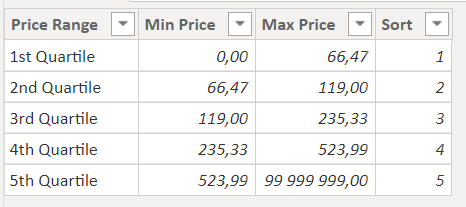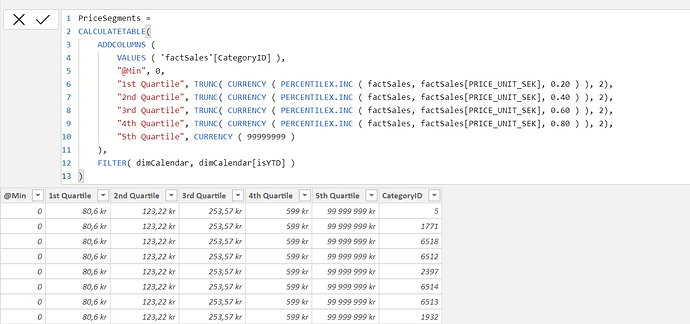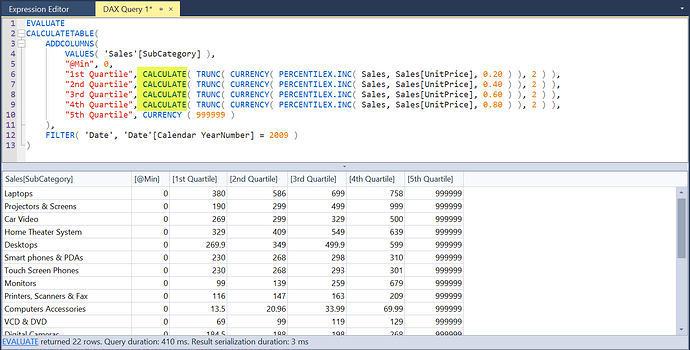Thanks a lot @BrianJ
This is roughly what I later want to achieve and then be able to filter on each category. Got the inspiration from Sam in one of the courses on “dynamic banding” or a similar name 
Y-Axis
Sales Per PriceSegment =
SUMX (
VALUES ( 'Date'[Year] ),
VAR ProductsInSegment =
FILTER (
ALLSELECTED ( Product[ARTICLE] ),
VAR SalesOfProduct = [Sales Price]
VAR SegmentForProduct =
FILTER (
'PriceSegments',
NOT ISBLANK ( SalesOfProduct )
&& 'PriceSegments'[Min Price] < SalesOfProduct
&& 'PriceSegments'[Max Price] >= SalesOfProduct
)
VAR IsProductInSegments = NOT ISEMPTY ( SegmentForProduct )
RETURN
IsProductInSegments
)
VAR Result =
CALCULATE ( [Sales], KEEPFILTERS ( ProductsInSegment ) )
RETURN
Result
)
.
X-Axis
Sales Price Segment =
SUMX (
VALUES ( 'Calendar'[Year] ),
VAR ProductsInSegment =
FILTER (
ALLSELECTED ( Product[ARTICLE] ),
VAR SalesOfProduct = [Sales Price]
VAR SegmentForProduct =
FILTER (
'PriceSegments',
NOT ISBLANK ( SalesOfProduct )
&& 'PriceSegments'[Min Price] < SalesOfProduct
&& 'PriceSegments'[Max Price] >= SalesOfProduct
)
VAR IsProductInSegments = NOT ISEMPTY ( SegmentForProduct )
RETURN
IsProductInSegments
)
VAR Result =
CALCULATE ( [Sales Price], KEEPFILTERS ( ProductsInSegment ) )
RETURN
Result
)
.
The only problem with the above measures is that they relied on a table that looked like this

with this dax
PriceSegments =
UNION (
ROW (
"Price Range", "1st Quartile",
"Sort", INT( 1),
"Min Price", CURRENCY ( 0 ),
"Max Price", CURRENCY ( PERCENTILEX.INC ( factSales, factSales[PRICE_UNIT_SEK], 0.20 ) )
),
ROW (
"Price Range", "2nd Quartile",
"Sort", INT( 2),
"Min Price", CURRENCY ( PERCENTILEX.INC ( factSales, factSales[PRICE_UNIT_SEK], 0.20 ) ),
"Max Price", CURRENCY ( PERCENTILEX.INC ( factSales, factSales[PRICE_UNIT_SEK], 0.40 ) )
),
ROW (
"Price Range", "3rd Quartile",
"Sort", INT( 3),
"Min Price", CURRENCY ( PERCENTILEX.INC ( factSales, factSales[PRICE_UNIT_SEK], 0.40 ) ),
"Max Price", CURRENCY ( PERCENTILEX.INC ( factSales, factSales[PRICE_UNIT_SEK], 0.60 ) )
),
ROW (
"Price Range", "4th Quartile",
"Sort", INT( 4),
"Min Price", CURRENCY ( PERCENTILEX.INC ( factSales, factSales[PRICE_UNIT_SEK], 0.60 ) ),
"Max Price", CURRENCY ( PERCENTILEX.INC ( factSales, factSales[PRICE_UNIT_SEK], 0.80 ) )
),
ROW (
"Price Range", "5th Quartile",
"Sort", INT( 5),
"Min Price", CURRENCY ( PERCENTILEX.INC ( factSales, factSales[PRICE_UNIT_SEK], 0.80 ) ),
"Max Price", CURRENCY ( 99999999 )
)
)
.
So I will need to think that one through as well 

 Will continue to have at it, and hopefully have a solution back to you later today.
Will continue to have at it, and hopefully have a solution back to you later today.



